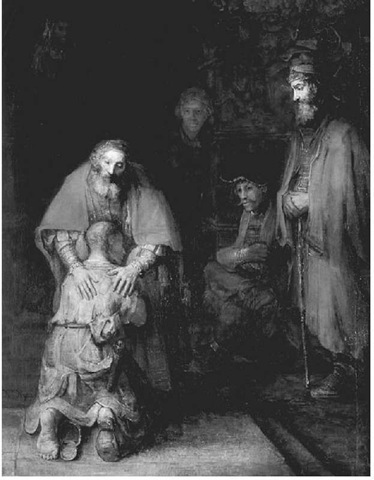Fatherhood in Christianity is a complex concept including ideas of protection, possession, intimacy, human familial relationships, and the person of God, the Father of Jesus. To understand fatherhood and the love of the father in
Christianity, it is essential to look at the scriptural witness to the role of the father within the family and the identification of God as the Father.
Ancient writers frequently described ideal household relationships in terms of authority relationships between male householders and other groups including women, children, and slaves. Aristotle developed several basic codes for how men should rule their homes to produce a well-ordered city. When the apostle Paul wrote letters instructing new converts to Christianity, he used this same convention while focusing on the way that family should be ordered by love, in response to Jesus Christ (Ephesians 5-6). Within this context, Paul commanded husbands to love their wives in the manner Christ loved the church—with acts of self-sacrifice. Once this primary relationship is established, Paul then described how husbands who love their wives will be fathers that bring up their children in the training and instruction of the Lord. This type of intimate involvement ensures the father’s authority over the children. It also defines the true goal of Christian fatherhood as instruction for obedience to God, not self. This calling to instruct children is paired with the command not to exasperate one’s children (Ephesians 6:4). From this and other scriptures, the Christian image of fatherhood draws together ideas of authority, spiritual responsibility, affection, and intimacy.
By calling God, Father, and inviting his disciples to pray to God using the Aramaic term of endearment, Abba, or Dad, Jesus shaped the Christian notion of fatherhood. In the Old Testament, God is described as Father of his people—for example, in Psalms 2:7, the king is referred to as a son; in Hosea 11:1, the people of Israel are collectively described as “My son.” Jesus extended these notions to imply an essential relationship between himself and his God and Father. He claimed to be the Son sent by the Father to reveal the love, will, and way of the creator of the world and the God of Abraham. Jesus identified God as Father and prohibited his disciples from calling anyone on earth “Father,” because they had only one Father—God in heaven (Matthew 23:9). With his identification of God and his teaching, Jesus reoriented all family loyalty to the family of the church. He also radically declared that God’s loving-kindness must determine any Christian notion of fatherhood.
As a result of Jesus’ teaching, Christians are instructed against discovering how God is a father by examining the human experience of fatherhood and projecting a reified version onto God. Instead, Christians must listen to Jesus’ teaching on his Father’s kingdom or parables like the Prodigal Son to grasp the nature of God’s fatherhood. Additionally, Christians must see Jesus’ love and his way of using power as the Son of God the Father, to grasp the nature of true intimacy and true spiritual authority in families.
Christian reflection on fatherhood must use this standard to reconceive relationships between men, their wives, and their children. The failure to do this and critique implicit or explicit images of fatherhood in scripture has led to feminist critiques of the way that fatherhood is understood in relation to human families and the fatherhood of God. By renaming and reimagining the first person of the Trinity, feminist theologians have tried to change the way that the church speaks about—and speaks to—God. The implied connection is that the liberation of women requires the emasculation of God. Within Christian thinking, this challenge has led to renewed discussions of the way male and female are created in God the Father’s image, as well as the nature of religious language and the role of fathers within human families.
The Return of the Prodigal Son by Rembrandt Harmensz van Rijn.

